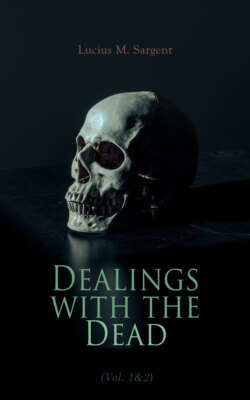Читать книгу Dealings with the Dead (Vol. 1&2) - Lucius M. Sargent - Страница 26
На сайте Литреса книга снята с продажи.
No. XXI.
ОглавлениеTable of Contents
It is commonly supposed, that the burial of articles of value with the dead, is a practice confined to the Indian tribes, and the inhabitants of unenlightened regions; who fancied, that the defunct were gone upon some far journey, during which such accompaniments would be useful. Such is not the fact. Chilperic, the fourth king of France, came to the throne AD 456. In 1655 the tomb of Chilperic was accidentally discovered, in Tournay, “restoring unto the world,” saith Sir Thomas Browne, vol. 3, p. 466, “much gold adorning his sword, two hundred rubies, many hundred imperial coins, three hundred golden bees, the bones and horse-shoes of his horse, interred with him, according to the barbarous magnificence of those days, in their sepulchral obsequies.” Stow relates, in his survey of London, that, in many of the funeral urns, found in Spitalfields, there were, mingled with the relics, coins of Claudius, Vespasian, Commodus, and Antoninus, with lachrymatories, lamps, bottles of liquor, &c.
As an old sexton, I have a right to give my advice; and the public have a right to reject it. If I were the owner of a lot, in some well-governed cemetery, I would place around it a neat, substantial, iron fence, and paint it black. In the centre I would have a simple monument, of white marble, and of liberal dimensions; not pyramidal, but with four rectangular faces, to receive a goodly number of memoranda, not one of which should exceed a single line. I would have no other monument, slab, or tablet, to indicate particular graves. I would have a plan of this lot, and preserve it, as carefully, as I preserved my title papers. Probably I should keep a duplicate, in some safe place. When a body came to be buried, in that lot, I would indicate the precise location, on my plan, and engrave the name and the date of birth, and death, and nothing more, upon the monument. If the dryness and elevation of the soil allowed, I would dig the graves so deep, that the remains of three persons could repose in one grave, the uppermost, five or six feet below the surface. After the burial of the first, the grave would be filled up, and an even, sodded surface presented, as before, until re-opened. Thus, of course, those, who had been lovely and pleasant, in their lives, like Jonathan and Saul, would, in death, be not divided. This, so far from being objectionable, is a delightful idea, embalmed in the classical precedents of antiquity. It is a well-known fact, that urns of a very large size were, occasionally, in use, in Greece and Rome, for the reception and commingling of the ashes of whole families. The ashes of Achilles were mingled with those of his friend, Patroclus. The ashes of Domitian, the last, and almost the worst, of the twelve Cæsars, were inurned, as Suetonius reports, ch. 17, with those of Julia.
With the Chinese, it is very common to bury a comb, a pair of scissors to pare the nails, and four little purses, containing the nail parings of the defunct. Jewels and coins of gold are sometimes inserted in the mouths of the wealthy. This resembles the practice of the Greeks and Romans, of placing an obolus, Charon’s fee, in the mouth of the deceased. This arrangement, in regard to the nail parings, seems well enough, as they are clearly part and parcel, of the defunct. Rings, coins, and costly chalices have been found, with the ashes of the dead.
Avarice, curiosity, and revenge, personal or political, have prompted mankind, in every age, to desecrate the receptacles of the dead. The latter motive has operated more fiercely, upon the people of France, than upon almost any other. No nation has ever surpassed them, in that intense ardor, nor in the parade and magnificence, with which they canonize—no people upon earth can rival the bitterness and fury, with which they curse. Lamartine, in his history of the Girondists, states, that “dragoons of the Republic spread themselves over the public places, brandishing their swords, and singing national airs. Thence they went to the church of Val de Grace, where, enclosed in silver urns, were the hearts of several kings and queens of France. These funeral vases they broke, trampling under foot those relics of royalty, and then flung them into the common sewer.” And how shall we deal with the dead?
With a reasonable economy of space, a lot of the common area, at Mount Auburn, or Forest Hills, will suffice, for the occasion of a family of ordinary size, for several generations. In re-opening one of these graves, for a second or third interment, the operative should never approach nearer than one foot to the coffin beneath. The careless manner, in which bones are sometimes spaded up, by grave-diggers, results from their want of precise knowledge of previous inhumations. Common sense indicates the propriety of keeping a regular, topographical account of every interment.
But it is quite time to bring these lucubrations to a close. To some they may have proved interesting, and, doubtless, wearisome to others. The account is therefore balanced. Most heartily do I wish for every one of my readers a decent funeral, and a peaceful grave. I have tolled my last knell, turned down my last sod, and am no longer a Sexton of the Old School.
